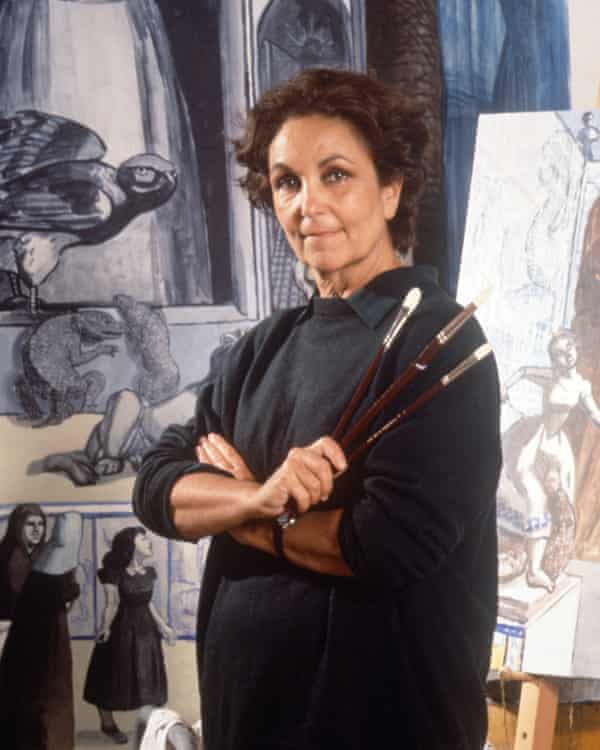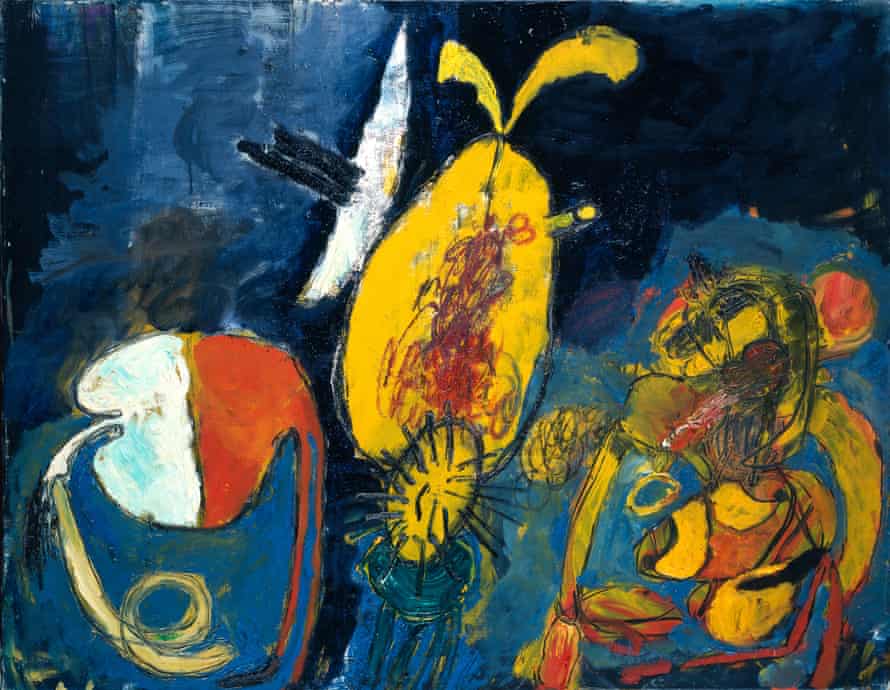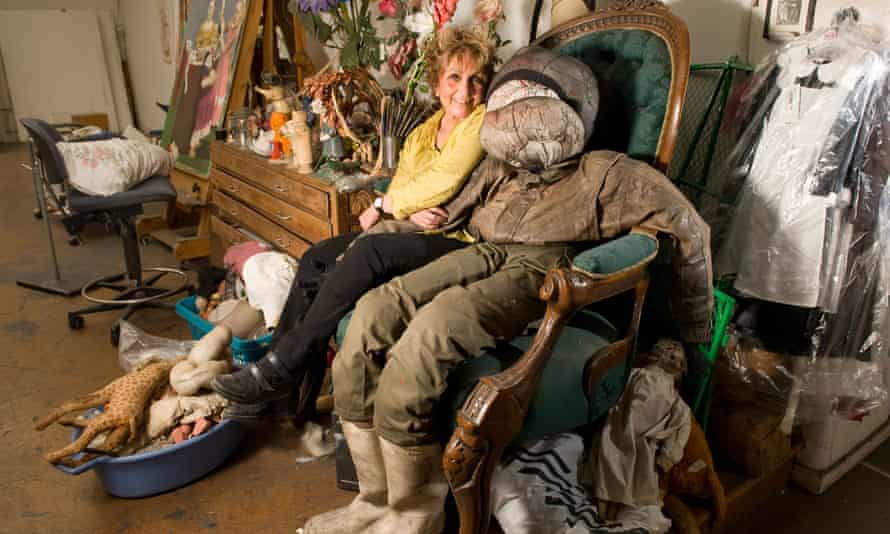 |
| Paula Rego in front of Dogs of Barcelona, 1965 |
Dame Paula Rego obituary
Michael McNay
Wenesday 8 June 2022
The anger that built up in her years of subjection to the men in her life – even her husband, Victor Willing, who took up years of her life as she nursed him – enabled her to deploy her art as a political weapon. One of her most famous paintings, The Policeman’s Daughter (1987), needs no interpretation: in it, a scowling young woman cleans her father’s jackboot with one hand while she shoves the other arm up inside it.

Rego was remorselessly described as a storyteller, which was true, and which cuts across the thrust of the art of the past century (with the exception of surrealism). She claimed her favourite painting was Max Ernst’s depiction of the Virgin Mary spanking the child Jesus. And it helps to know what she thought she was about (her stories changed with each telling), but no more than it helps looking at certain Titians or Picassos to know the myths in Ovid’s Metamorphoses. The bottom line was the sheer visual power of her work, in painting, in fluently wonderful drawings, and in etching and aquatints, carried by a magnificent technique.
When the post-revolution Portuguese – of which Rego was one – ducked out of legalising abortion by simply not turning out to vote in the referendum, she created a series of paintings that exploded like a powder keg in her home country and in Spain. Her masterpiece in this series is the triptych of 1998 showing sordid back-street abortion parlours in rooms sparsely equipped with a bed and a plastic stacking chair, or an armchair with its cover worn into holes. In one canvas, a woman is curled up in foetal misery; in the second, a woman draws her legs up and braces herself as she grasps her thighs; in the third, a schoolgirl still wearing her blouse and tie draws up her skirt and straddles a plastic bucket as she glares out at the viewer.
A 1995 series of female ballet dancers of almost brutal appearance, utterly subverting the tradition of Pavlova and Sylvie Guillem, is curiously reminiscent of Degas. This is not merely because of the subject, nor because Degas, too, took a backstage view of dancers, though through the keyhole of male fascination rather than Rego’s gutsy and head-on truth-telling; but because by this time Rego too was working in pastel, an urgent medium that combines the swiftness of drawing with the completeness of painting.
Most of her late and best work was done in pastel, including the Buñuel-esque take on a bride in a white silk dress and veil lying submissively on her back (1994), and the series of the same year of women behaving like dogs, scavenging or ingratiating themselves, cowed but utterly aware of their own sexuality. There is nothing else in art like them.
![Dog Woman, 1994, ‘cowed but utterly aware of [her] own sexuality’, by Paula Rego.](https://i.guim.co.uk/img/media/d78b65725be8b4b28d0b4094adc6e69b910d2327/0_0_3088_2271/master/3088.jpg?width=445&quality=45&auto=format&fit=max&dpr=2&s=0053f5fc21cb9d236c5308113081b9e2)
Rego was born in Lisbon under the fascist Salazar dictatorship, which, with Roman Catholicism stirred into the mix, was an unholy brew. Women were expected to be seen and not heard. The Regos were middle class and anglophile.
Paula’s father, José, was an electrical engineer who worked for Marconi; her mother, Maria, ran the home, which had maids and a cook. When Paula was 18 months old her parents moved to London for a year for her father’s work, and she was looked after by her grandparents and an ageing aunt. After her parents’ return, Paula, aged three, was diagnosed with tuberculosis, and the family moved to the seaside town of Estoril, spending summers in the fishing village of Ericeira, for her health.
She attended St Julian’s school, an English foundation in Carcavelos, near Lisbon, then was sent to Britain to a finishing school, the Grove, in Kent. In 1952 she went to the Slade School of Fine Art, London, to study painting.
In 1954, Under Milk Wood was first broadcast on BBC radio, and it became as popular a talking point in offices and pubs as television’s EastEnders might now (which, incidentally, was one of the few things that regularly drew her away from the studio in later years).
The infection spread to the Slade, where the 19-year-old Rego made her own version of the play in oils on canvas. She brilliantly translated Dylan Thomas’s characters from the imaginary Welsh village into a Portuguese idiom of sunbaked peasants. With this painting she came joint first for the Slade summer composition prize. And then, full stop.
While at the Slade, Rego had met Willing, who was married, seven years older than her, and reckoned by many to be the best painter of his generation. In 1956, Rego’s final year at college, she became pregnant and went home to Portugal to have the baby. Willing left his wife, joined Rego in Portugal, and in 1959 they married, and went on to have two more children. He encouraged her to continue drawing to cope with depression, but though she had now developed a powerful line, effectively she disappeared from public view, even though she often visited and kept a studio in Charlotte Street, central London.
In 1966 Willing developed multiple sclerosis and 10 years later the family went back to London permanently. Apart from a couple of shows in Lisbon in the 1970s, Rego dropped out of sight. In 1981, at the age of 46, virtually out of nowhere, she had an eye-opening first London show, at the AIR Gallery, but – paralleling the career of Jackson Pollock’s wife, Lee Krasner, and who knows how many more – not until Willing died in 1988 did she feel fully able to compete in public.

Rego once said that she tried abstraction but was no good at it. On the contrary, her early work, abstract expressionist for want of a better term, was as disruptive as her later figuration: Birth (1959) or Salazar Vomiting the Homeland (1960), which, like most of her paintings of that period, fetched up in Portuguese collections, already had a disconcertingly raw power driven by anger.
Later, Willing told her that when he was a child his toys were rag dolls of animals from which he made a theatre. She took up this notion and created a theatre of her own, on canvas, of bears and red monkeys, not winsome bedroom teddies, but mutated and vicious human-like creatures: in one painting, the red monkey’s wife cuts his tail off while he vomits. Willing knew what was going on in this symbolism, and encouraged her. He was always her best critic and his writings are still the best authority on her work.
Early in the 90s Rego became the first artist-in-residence at the National Gallery in London, and while there she carried out a commission to paint a huge mural for the restaurant in the Sainsbury wing. She took her title, Crivelli’s Garden, from a portion of the background to a painting by the 15th-century Venetian Carlo Crivelli and, suppressing the acerbic aspect of her work, set down a gathering of female saints, all of whom figured in paintings in the gallery, all of them at humble daily tasks, all survivors, in an affecting homage to womankind.

Tate Liverpool hung a Rego retrospective in 1996. Other major national and international shows followed, including two more retrospectives at Tate Britain, in 2004 and 2021. In 2005 she was commissioned by Royal Mail to create a set of postage stamps in celebration of Charlotte Brontë’s Jane Eyre.
Her son, Nick, directed a BBC documentary on his mother, Paula Rego: Secrets and Stories, in 2017. In 2010, she was made a dame, a curiously antique award for such a powerfully feminist artist.
For the last quarter of a century the writer and translator Anthony Rudolf was Rego’s companion and principal male model.
She is survived by her children, Nick, Caroline and Victoria.
Maria Paula Figueiroa Rego, artist, born 26 January 1935; died 8 June 2022
THE GUARDIAN

No comments:
Post a Comment